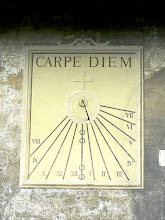SAINT MENAS, of EGYPT
SAINT MENAS of EGYPT - (of Mareotis, of Cotyaes or Cotyaeum, of Constantinopla)
_______________________________________________________________________________

FLASK of ST. MENAS, (late 500s- mid 700s) Terracotta
Probably made at Abu Mareotis, near Alexandria, Egypt
8.9 x 6.4 cms. (3.5 x 2.5 inches)
______________________________________________________
SAINT MENAS
===========
The Coptic Christians hold that Menas's burial site is located in or near Memphis, on the head of the Nile delta.
Martyr under Diocletian, about 295.
According to the Greek Acts published with Latin translation in "Analecta Bollandiana", III 258 (Surlus XI 241), Menas, a Christian and an Egyptian by birth, served in the Roman army under the tribune Firmilian. When the army came to Cotyaeus in Phrygia.
Menas hearing of the impious edicts issued against the Christians by the Emperors Diocletian and Maximian left the army, retired to a solitude in the mountains and served God by fasting vigils and prayer.
During the celebration of a great festival Menas appeared in the midst of the populous in the circus, and fearlessly professed his faith.
He was led before the prefect Pyrrhus, cruelly scourged, put to torture and finally beheaded.
His body was brought to Egypt and the martyr was soon invoked in many needs and afflictions.
The fame of the miracles wrought, spread far and wide and thousands of pilgrims came to the grave in the desert of Mareotis between Alexandria and the valley of Natron.
For centuries Bumma (Karm-Abum-Abu Mina) was a national sanctuary and grew into a large city with costly temples, a holy well, and baths.
A beautiful basilica was erected there by the Emperor Arcadius.
The cult was spread into other countries, perhaps by traveling merchants who honoured him as their patron.
As a result of various vicissitudes the doctrinal disputes and the conquest of Egypt by the Arabians under Omar in 641, the sanctuary was neglected and ultimately forgotten.
During 1905 Mgr C.M. Kaufmann of Frankfort led an expedition into Egypt which made excavations at Bumma.
He found in a vast field of ruins, the grave, the well and thermae, the basilica, the monastery, numerous inscriptions on the walls imploring aid through the intercession of the saint, and thousands of little water pitchers and oil lamps.
The rich finds are partly in the Museum of Alexandria and Cairo, and partly in Frankfort and Berlin.
The monsignor published an official report of his expedition in 1908, "La découverte des Sanctuaires de Menas dans le désert de Mareotis". His feast is celebrated on 11 November.
Several saints of the name Menas were highly honoured in the ancient Church about whose identity or diversity much dispute is raised.
Delahaye (Anal. Boll., XXIX, 117) comes to the conclusion that Menas of Mareotis, Menas of Cotyaes, and Menas of Constantinople, surnamed Kallikelados, are one and the same person, that he was an Egyptian and suffered martyrdom in his native place, that a basilica was built over his grave which became one of the great sanctuaries of Christendom, that churches were built in his honour at Cotyaeus and Constaninople, and gave rise to local legends.
Another profile says that:
MENAS of EGYPT may have been a camel driver in his earlier civilian life. He was a christian, of copt Egyptian faith.
And then became a soldier in the Imperial Roman Army, serving under Firmilian.
During the antichristian persecutions of Diocletian and Maximinian, MENAS left the army and retired for a while as a mountain or desert hermit.
He was tried befor Prefect Pyrrhus, scourged, tortured and martyred.
He was buried in Egypt, at Mareotis, a place between Alexandria and Natron in the Lybian desert. His grave became known as a place of miracles. A basilica was built over his grave and became one of the great Sanctuaries of Christendom.
It was called the "Glory of the Lybian desert".
Merchants travelling through the area spread stories about him, and the Churches that were built in Cotyaeus and Constantinople under his name, gave rise to local legends about him.
The Basilica was destroyed and his tomb lost in the seventh century (S. VII A.D.)
Was rediscovered in an archeological expedition in 1905.
Saint MENAS, bor Egyptian, beheaded circa 300 A.D. at Cotyaes. Buried at Mareotis, Egypt.
Patron Saint of the wrong accused or false guilty. Of the travelling vendors and of the travelling merchants.
=========================================
..


0 Comments:
Post a Comment
<< Home